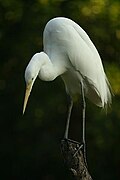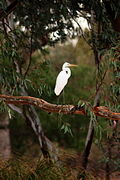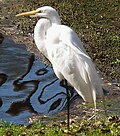Difference between revisions of "Field Guide/Birds/Ardea alba"
| (10 intermediate revisions by the same user not shown) | |||
| Line 9: | Line 9: | ||
| ordo = [[Ciconiiformes]] | | ordo = [[Ciconiiformes]] | ||
| familia = [[Ardeidae]] | | familia = [[Ardeidae]] | ||
| − | | genus = ''[[ | + | | genus = ''[[Ardea (genus)|Ardea]]'' |
| − | | species = ''''' | + | | species = '''''A. alba''''' |
| − | | binomial = '' | + | | binomial = ''Ardea alba'' |
| − | |||
| subdivision_ranks = Synonyms | | subdivision_ranks = Synonyms | ||
| subdivision = | | subdivision = | ||
| − | * '' | + | *''Casmerodius albus'' |
* ''Egretta alba'' | * ''Egretta alba'' | ||
}} | }} | ||
| − | The Great Egret ('' | + | The Great Egret (''Ardea alba''), also known as the ''' Great White Egret''', '''White Heron''', or '''Common Egret''', is a wading [[egret]], found in most of the tropical and warmer temperate parts of the world, although it is very local in southern [[Europe]] and [[Asia]]. It is called '''Kōtuku''' in [[New Zealand]]. It should not be confused with the Great White Heron, which is a white morph of the [[Great Blue Heron]] found in [[Florida]]. |
The Great Egret is a large bird with all white plumage, as much as 101 cm long and weighing up to 950 g. It is only slightly smaller than the Great Blue or [[Grey Heron]]s. Apart from size, the Great Egret can be distinguished from other white egrets by its yellow bill and black legs and feet. It also has a slow flight, with its neck retracted. This is characteristic of herons and [[bittern]]s, and distinguishes them from [[stork]]s, [[crane (bird)|crane]]s and [[spoonbill]]s, which extend their necks. | The Great Egret is a large bird with all white plumage, as much as 101 cm long and weighing up to 950 g. It is only slightly smaller than the Great Blue or [[Grey Heron]]s. Apart from size, the Great Egret can be distinguished from other white egrets by its yellow bill and black legs and feet. It also has a slow flight, with its neck retracted. This is characteristic of herons and [[bittern]]s, and distinguishes them from [[stork]]s, [[crane (bird)|crane]]s and [[spoonbill]]s, which extend their necks. | ||
| Line 29: | Line 28: | ||
==Conservation status== | ==Conservation status== | ||
| − | Although generally a very successful species with a large and expanding range, the Great Egret is highly endangered in New Zealand [http://www.nzbirds.com/Kotuku.html], [http://www.wellingtonzoo.com/animals/animals/natives/kotuku.html]. In [[North America]], large numbers of Great Egrets were killed around the end of the [[19th century]] so that their plumes could be used to decorate hats. Numbers have since recovered as a result of conservation measures. Its range has expanded as far north as southern [[Canada]]. However, in some parts of the southern [[United States]], its numbers have declined due to habitat loss. This bird has been chosen as the symbol of the [[National Audubon Society]], which was formed in part to prevent birds from being killed for their feathers. | + | Although generally a very successful species with a large and expanding range, the Great Egret is highly endangered in New Zealand [http://www.nzbirds.com/Kotuku.html], [http://www.wellingtonzoo.com/animals/animals/natives/kotuku.html]. In [[North America]], large numbers of Great Egrets were killed around the end of the [[19th century]] so that their plumes could be used to decorate hats. Numbers have since recovered as a result of conservation measures. Its range has expanded as far north as southern [[Canada]]. However, in some parts of the southern [[United States]], its numbers have declined due to habitat loss. This bird has been chosen as the symbol of the [[National Audubon Society]], which was formed in part to prevent birds from being killed for their feathers. |
| + | |||
They are Protected in Australia under the National Parks and Wildlife Act, 1974. | They are Protected in Australia under the National Parks and Wildlife Act, 1974. | ||
| Line 35: | Line 35: | ||
==Taxonomy== | ==Taxonomy== | ||
| − | Various authors also identify this species as ''Egretta alba'' and '' | + | Various authors also identify this species as ''Egretta alba'' and ''Casmerodius albus''. However, this species closely resembles the large ''Ardea'' herons such as [[Grey Heron]] and [[Great Blue Heron]] in everything but colour, whereas it shows fewer similarities to the smaller white egrets. |
| − | There are four subspecies in various parts of the world, of which the largest is '' | + | There are four subspecies in various parts of the world, of which the largest is ''A. a. modesta''. |
===Subspecies=== | ===Subspecies=== | ||
| − | * '' | + | * ''A. a. modesta'' - Asia and [[Australasia]]. |
| − | * '' | + | * ''A. a. alba'' - [[Europe]] |
| − | * '' | + | * ''A. a. egretta'' - [[North America]] |
| − | * '' | + | * ''A. a. melanorhynchos'' - [[Africa]] |
<gallery> | <gallery> | ||
| − | Image:Lightmatter egret.jpg | + | Image:Lightmatter egret.jpg |
| − | Image:Egretta_alba_1_(Marek_Szczepanek).jpg | + | Image:Egretta_alba_1_(Marek_Szczepanek).jpg |
| − | Image:Egretta_alba_2_(Marek_Szczepanek).jpg | + | Image:Egretta_alba_2_(Marek_Szczepanek).jpg |
Image:Ardea alba1.jpg | Image:Ardea alba1.jpg | ||
Image:Ardea alba2.jpg | Image:Ardea alba2.jpg | ||
Image:Ardea alba3.jpg | Image:Ardea alba3.jpg | ||
| − | Image:Kaippally%27s_Egretta_Alba.JPG| | + | Image:Kaippally%27s_Egretta_Alba.JPG|Ras al Khor [[Dubai]] |
| − | Image:DSC00379.JPG| | + | Image:DSC00379.JPG|On railing |
| − | Image:Great Egret 02.jpg|[[Birds of Australia| | + | Image:Great Egret 02.jpg|[[Birds of Australia|Australia]] |
| − | Image:Garça Grande(REFON).jpg|[[Brazil]] | + | Image:Garça Grande(REFON).jpg|[[Brazil]] |
| + | Image:C.a.egretta louisiana.jpg|[[Louisiana]] | ||
</gallery> | </gallery> | ||
| Line 64: | Line 65: | ||
*{{ITIS|ID=554135|taxon=Ardea alba|year=2006|date=9 February}} | *{{ITIS|ID=554135|taxon=Ardea alba|year=2006|date=9 February}} | ||
| − | *''Peterson, | + | *''Peterson, Roger T. Peterson Field Guides: Eastern Birds. 4th ed. New York: Houghton Mifflin. 102.'' |
==External links== | ==External links== | ||
| Line 74: | Line 75: | ||
{{commons|Great Egret}} | {{commons|Great Egret}} | ||
| + | |||
| + | {{DEFAULTSORT:Egret, Great}} | ||
[[Category:Ardeidae]] | [[Category:Ardeidae]] | ||
| − | [[Category:Wading birds | + | [[Category:Wading birds]] |
| − | [[Category: | + | [[Category:Birds of the United States]] |
| − | [[Category: | + | [[Category:Birds of New Zealand]] |
[[Category:Birds of Australia]] | [[Category:Birds of Australia]] | ||
[[Category:Birds of Guyana]] | [[Category:Birds of Guyana]] | ||
| Line 111: | Line 114: | ||
[[cs:Volavka bílá]] | [[cs:Volavka bílá]] | ||
[[de:Silberreiher]] | [[de:Silberreiher]] | ||
| − | [[fr: | + | [[eo:Granda egretardeo]] |
| + | [[es:Ardea alba]] | ||
| + | [[fr:Ardea alba]] | ||
[[it:Casmerodius albus]] | [[it:Casmerodius albus]] | ||
[[lt:Didysis baltasis garnys]] | [[lt:Didysis baltasis garnys]] | ||
[[hu:Nagy kócsag]] | [[hu:Nagy kócsag]] | ||
| + | [[mi:Kōtuku]] | ||
[[ms:Burung Bangau Besar]] | [[ms:Burung Bangau Besar]] | ||
[[nl:Grote zilverreiger]] | [[nl:Grote zilverreiger]] | ||
| Line 120: | Line 126: | ||
[[no:Egretthegre]] | [[no:Egretthegre]] | ||
[[pl:Czapla biała]] | [[pl:Czapla biała]] | ||
| + | [[qu:Jatun Waqar]] | ||
[[ru:Цапля большая белая]] | [[ru:Цапля большая белая]] | ||
[[fi:Jalohaikara]] | [[fi:Jalohaikara]] | ||
[[sv:Ägretthäger]] | [[sv:Ägretthäger]] | ||
[[zh:大白鹭]] | [[zh:大白鹭]] | ||
Revision as of 17:07, 25 February 2007
The Great Egret (Ardea alba), also known as the Great White Egret, White Heron, or Common Egret, is a wading egret, found in most of the tropical and warmer temperate parts of the world, although it is very local in southern Europe and Asia. It is called Kōtuku in New Zealand. It should not be confused with the Great White Heron, which is a white morph of the Great Blue Heron found in Florida.
The Great Egret is a large bird with all white plumage, as much as 101 cm long and weighing up to 950 g. It is only slightly smaller than the Great Blue or Grey Herons. Apart from size, the Great Egret can be distinguished from other white egrets by its yellow bill and black legs and feet. It also has a slow flight, with its neck retracted. This is characteristic of herons and bitterns, and distinguishes them from storks, cranes and spoonbills, which extend their necks.
Habits
The Great Egret feeds in shallow water or drier habitats, spearing fish, frogs or insects with its long, sharp bill. It will often wait motionless for prey, or slowly stalk its victim. It is a conspicuous species, usually easily seen.
The Great Egret is partially migratory, with northern hemisphere birds moving south from areas with cold winters. It breeds in colonies in trees close to large lakes with reed beds or other extensive wetlands. It builds a bulky stick nest. The call at breeding colonies is a loud croaking "cuk cuk cuk".
Conservation status
Although generally a very successful species with a large and expanding range, the Great Egret is highly endangered in New Zealand [1], [2]. In North America, large numbers of Great Egrets were killed around the end of the 19th century so that their plumes could be used to decorate hats. Numbers have since recovered as a result of conservation measures. Its range has expanded as far north as southern Canada. However, in some parts of the southern United States, its numbers have declined due to habitat loss. This bird has been chosen as the symbol of the National Audubon Society, which was formed in part to prevent birds from being killed for their feathers.
They are Protected in Australia under the National Parks and Wildlife Act, 1974.
The Great Egret is one of the species to which the Agreement on the Conservation of African-Eurasian Migratory Waterbirds (AEWA) applies.
Taxonomy
Various authors also identify this species as Egretta alba and Casmerodius albus. However, this species closely resembles the large Ardea herons such as Grey Heron and Great Blue Heron in everything but colour, whereas it shows fewer similarities to the smaller white egrets.
There are four subspecies in various parts of the world, of which the largest is A. a. modesta.
Subspecies
- A. a. modesta - Asia and Australasia.
- A. a. alba - Europe
- A. a. egretta - North America
- A. a. melanorhynchos - Africa
- Kaippally's Egretta Alba.JPG
Ras al Khor Dubai
- DSC00379.JPG
On railing
References
- Template:IUCN2006 Database entry includes justification for why this species is of least concern
- Handbook of the Birds of Europe, the Middle East, and North Africa: The Birds of the Western Palearctic
- Template:ITIS
- Peterson, Roger T. Peterson Field Guides: Eastern Birds. 4th ed. New York: Houghton Mifflin. 102.
External links
- The Great White Egret Image documentation
- The Great White Egret Photos
- Great Egret Information - Cornell Lab of Ornithology
- Great Egret Information and Photos - South Dakota Birds and Birding
- Great Egret Information - USGS Patuxent Bird Identification InfoCenter
af:Grootwitreier bg:Голяма бяла чапла cs:Volavka bílá de:Silberreiher eo:Granda egretardeo es:Ardea alba fr:Ardea alba it:Casmerodius albus lt:Didysis baltasis garnys hu:Nagy kócsag mi:Kōtuku ms:Burung Bangau Besar nl:Grote zilverreiger ja:ダイサギ no:Egretthegre pl:Czapla biała qu:Jatun Waqar ru:Цапля большая белая fi:Jalohaikara sv:Ägretthäger zh:大白鹭
- Pages with broken file links
- Ardeidae
- Wading birds
- Birds of the United States
- Birds of New Zealand
- Birds of Australia
- Birds of Guyana
- Birds of Puerto Rico
- Fauna of Trinidad and Tobago
- Birds of Kenya
- Birds of India
- Fauna of Sri Lanka
- Fauna of Nepal
- Fauna of Russia
- Fauna of Mongolia
- Fauna of Pakistan
- Birds of China
- Fauna of Korea
- Birds of Japan
- Fauna of Southeast Asia
- Fauna of Bangladesh
- Fauna of Myanmar
- Fauna of Vietnam
- Fauna of Laos
- Fauna of Cambodia
- Fauna of Thailand
- Fauna of Malaysia
- Fauna of Singapore
- Fauna of Brunei
- Fauna of Indonesia
- Fauna of the Philippines
- Birds of Western Australia









